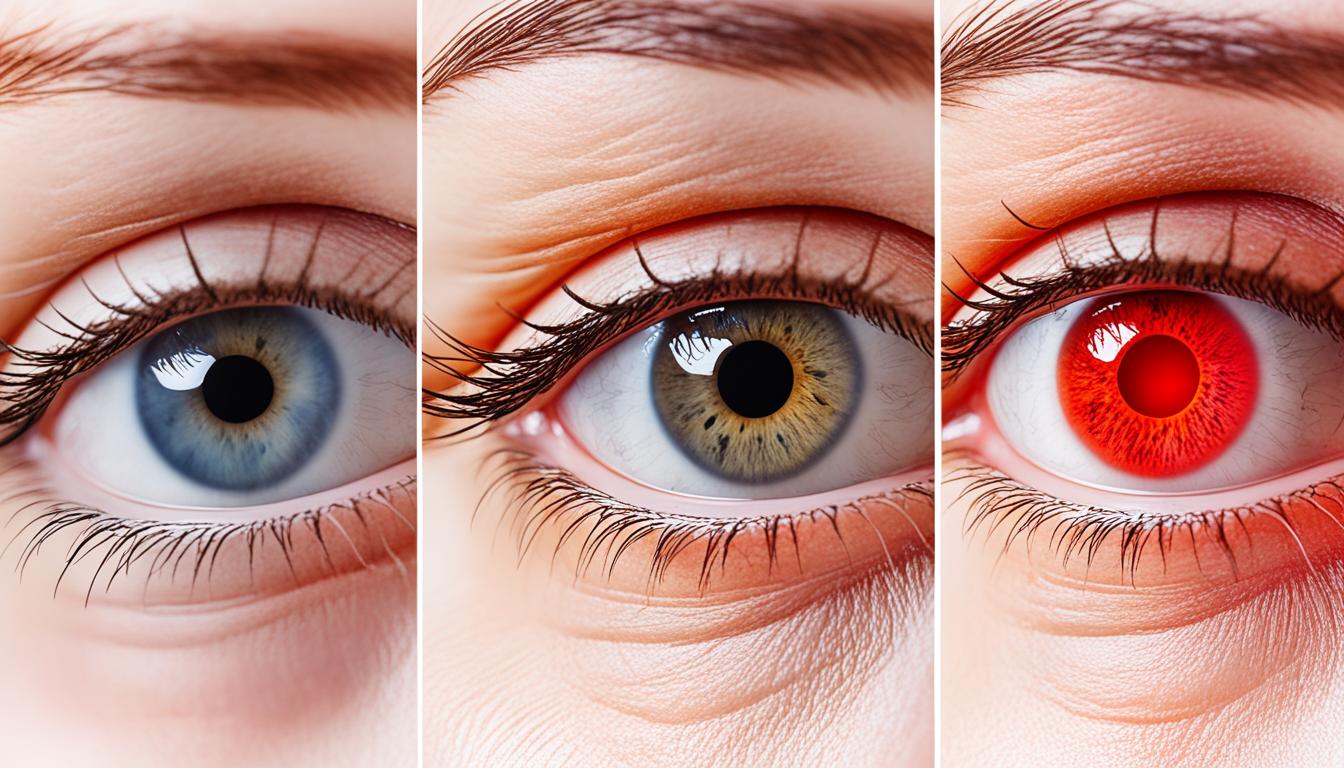Keratoconjunctivitis sicca is a complex eye disease. It affects the tears and the area around the eyes. This can cause discomfort, issues with vision, and makes the eyes feel unstable. People over 50 are more likely to get this; it might also happen with other health problems like Sjögren syndrome. Signs are discomfort, feeling like something’s in your eye, burning, and dryness. Doctors can tell by checking your eyes and using tests. Treatments range from using special eye drops to something called stem cell therapy for the worst cases.
Key Takeaways:
- Keratoconjunctivitis sicca, also known as dry eye syndrome, affects the tears and ocular surfaces.
- Common symptoms include eye discomfort, grittiness, burning, and dryness.
- Diagnosis involves clinical examination and tests like the Schirmer’s test and Rose Bengal staining.
- Treatment options include artificial tears, closing off part of the eye, and stem cell therapy.
- This problem is more likely with age, and it might link to autoimmune diseases.
Causes of Keratoconjunctivitis Sicca
Keratoconjunctivitis sicca, or dry eye syndrome, has many causes. It’s key to know these causes to treat it well.
Autoimmune Conditions
Autoimmune conditions like Sjögren syndrome and arthritis are a key cause. They make the immune system wrongly attack the tear-making glands. This leads to less tears and dry eyes.
Tear Film Dysfunction
Tear film dysfunction is also a cause. The tear film is made of an oily, watery, and mucus layer. If any layer doesn’t work right, it can’t keep your eyes moist. This makes your eyes feel dry and irritated.
Environmental Factors
Where you are can also make your eyes dry. Dry places, smoke, wind, and using devices a lot can make your tears evaporate faster. This messes up the balance of your tear film, causing dry eyes.
Hormonal Changes, Aging, and Medications
Changes in hormones, especially during menopause, can decrease the tears you make. Getting older also means less and lower quality tears. Medicines like antihistamines, decongestants, and some antidepressants can make it worse too.
Knowing what causes dry eyes helps doctors treat it better. They can focus on what’s really going on. This brings relief to many with this issue.
Diagnosis of Keratoconjunctivitis Sicca
Diagnosing keratoconjunctivitis sicca means checking symptoms and examining the eyes. Eye doctors run tests to confirm a dry eye diagnosis. They also look for the cause of the problem.
Schirmer’s Test
Doctors often use the Schirmer’s test to see how many tears you make. They place a small paper strip under your eyelid to catch tears. This helps them measure your tear levels. Low amounts of tears suggest dry eye syndrome is likely.
Rose Bengal Staining
Another test is Rose Bengal staining. Here, a dye is used to show eye damage. The dye makes issues like corneal defects clear. It helps doctors see how bad the dry eye has affected the eyes.
Tear Film Breakup Time
Tear Film Breakup Time (TFBUT) looks at tear film stability. The doctor watches how the tear film breaks up on the eye. A quick breakup means the tears are not quality. This is a sign of dry eyes.
Additional Diagnostic Tests
Doctors also check the meibomian glands and corneal sensitivity. They see if the glands that make an oil layer for tears are working. They check if the cornea is less sensitive, which might mean dry eyes.
By doing all these tests, doctors can get a full picture of the dry eye problem. This helps them choose the best treatments. The goal is to relieve the symptoms and make the eyes healthier.
| Diagnostic Test | Description |
|---|---|
| Schirmer’s Test | Absorbs tears to measure tear production |
| Rose Bengal Staining | Highlights damaged areas on the ocular surface |
| Tear Film Breakup Time | Evaluates tear film stability |
| Meibomian Gland Function Evaluation | Assesses the function of the meibomian glands |
| Corneal Sensitivity Assessment | Evaluates corneal sensitivity levels |
Example image related to the article:
Stem Cell Therapy for Keratoconjunctivitis Sicca
Stem cell therapy is a new and exciting way to treat keratoconjunctivitis sicca. This treatment uses stem cells to fix and grow new eye tissues. It helps make the eye’s surface healthier.
These special cells can come from the person needing treatment or someone else. This makes the treatment fit the person’s unique situation. Also, using a person’s own serum, or liquid part of blood, helps in treating dry eye syndrome.
The main aim of stem cell and serum therapy is to boost tears, lower eye surface swelling, and better life quality for people with keratoconjunctivitis sicca. Research is ongoing to fully understand and improve these treatments. Initial findings show they could change eye care and bring new hope for this eye problem.

